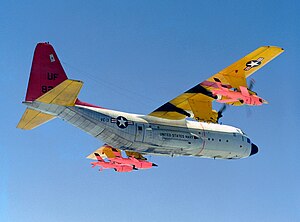DC-130 Hercules
| DC-130 Hercules | |
|---|---|
 |
|
| A US Navy DC-130H preparing to launch a pair of BQM-34 Firebee target drones. | |
| Role | Drone control aircraft |
| National origin | United States |
| Manufacturer | Lockheed |
| Primary users |
United States Air Force United States Navy |
| Developed from | C-130 Hercules |
The Lockheed DC-130 was a variant of the C-130 Hercules, designed for drone control. It could carry four Ryan Firebee drones underneath its wings.
Ever since World War I, many nations' air forces have investigated different means of remotely controlling aircraft. Spurred by the U-2 Crisis of 1960, the United States Air Force gained a renewed interest in using unmanned aerial vehicles, or drones, to gain intelligence on the SA-2 Guideline Surface-to-air missile system. Under the code names "Lightning Bug" and "Compass Cookie", Ryan 147A target drones were modified for reconnaissance. The drones were test flown over North Korea and China after the Gulf of Tonkin Incident in August 1964.
While perfect for reconnaissance, the use of a mere radar van for command, track and control limit the combat ability of the drones. The team controlling the drones was limited to a single, stationary recovery area. In order to improve the range and recoverability of the drones, some C-130As were modified to carry the drones on pylons under the wings and were re-designated as GC-130, MC-130 or DC-130.
The DC-130H project was tested at Hill Air Force Base, Utah with the 6514th Test Squadron. The aircraft was designed to carry and deploy up to four drones. In addition to its ability to deploy four drones, it could also provide control for up to 16 drones simultaneously.
...
Wikipedia
